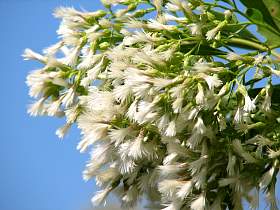False Cotton, Baccharis halimifolia 
shrub of the family Asteraceae
 Etymology: the name "false cotton" comes from the appearance of the fruits, with filaments like cotton-wool which the wind disperses. Etymology: the name "false cotton" comes from the appearance of the fruits, with filaments like cotton-wool which the wind disperses.
Origin: North America. Baccharis was introduced to France in 1680.
Habitat: sunny, half-shade.
Hardiness: zone 9.
Rate of Growth: fast.
Height: 5 m tall.
Shape: branched, in bowl.
Deciduous foliage. Leaves alternate (unlike Gomphocarpus fruticosus), thick, lozenge-shaped, with big teeth, with pale underside.
Flowers in August-September, involucre (tight altogether, without peduncles, at the end of a stem). The sunflower and the dandelion, of the same family, share this feature. The flowers of Baccharis are of yellow colour in white. They are melliferous (they attract the honeybees).
Fruits grouped as flowers, at the end of stems. They are endowed with long silky white egrets dispersed by the wind, which give an impression of tuft like cotton-wool. They are comparable to those of the dandelion.
Use: Bacccharis has useful depurative principles in the treatment of hepatic diseases.
Advices of planting:
It is a shrub pervading that you should not introduce without knowing its impact on the indigenous plants. On the banks of the Basin of Arcachon and of the Morbihan (Quiberon, Gâvres), it tends to replace the local flora by forming particularly prolific shrubs. Its reproduction capacity (up to a million seeds on a female foot, the life of a seed being of 5 years) and its adaptability makes it a formidable invasive plant. As it suckers from the roots, it is necessary to root it out to get rid of it.
Many villages decided to forbid the planting of Baccharis.
|